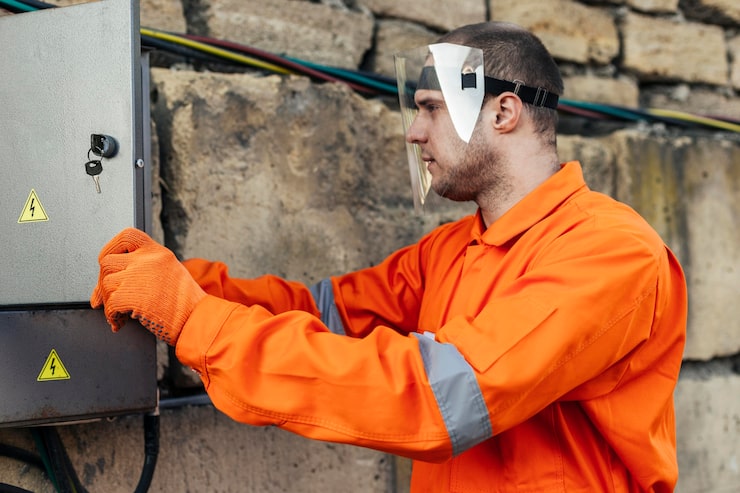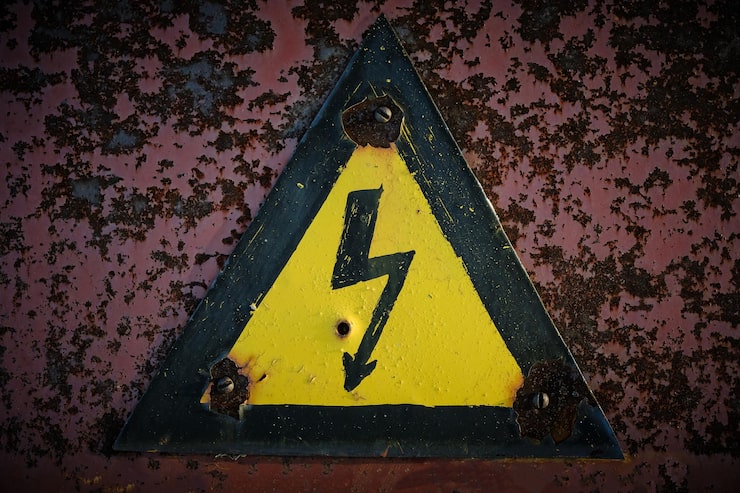Signs Your Electrical Panel Was Damaged in a Storm are critical to recognize because severe weather can compromise your home’s electrical system in ways that aren’t immediately obvious. Whether you’ve experienced heavy rain, lightning strikes, or high winds, your electrical panel may have sustained hidden damage that poses serious risks. Recognizing the signs your electrical panel was damaged in a storm is crucial, as post-weather conditions can lead to an immediate electrical hazard if the panel is compromised or overloaded.
From physical indicators like rust and corrosion to performance issues such as frequently tripped breakers and flickering lights, understanding these electricity warnings helps you act quickly. This comprehensive guide will help you identify how do I know if my house has an electrical fault, what happens when an electrical panel gets wet, and how do I know if my panel is overloaded. We’ll explore the danger electrical hazard scenarios, visible damage signs, and the immediate steps you should take to protect your family and property from potential fire and shock risks.
Understanding Storm Damage to Electrical Panels
Storms create multiple pathways for your electrical panel to sustain damage. Lightning strikes can send powerful surges through your home’s wiring system, even if they don’t directly hit your house. Heavy rain and flooding introduce moisture into areas that should remain completely dry, while falling debris from high winds can cause physical trauma to exterior electrical equipment. The electrical panel serves as the heart of your home’s power distribution system, managing the flow of electricity to every circuit in your residence. When storms compromise this critical component, the consequences range from minor inconveniences to life-threatening situations.
Water infiltration represents one of the most dangerous forms of storm damage. What happens when an electrical panel gets wet during a storm highlights the severe danger of fire and shock, necessitating an immediate inspection to prevent a serious electrical hazard. Moisture creates conductive pathways where they shouldn’t exist, leading to short circuits, corrosion, and potential electrical fires. Even a small amount of water can trigger oxidation processes that weaken connections and create resistance points that generate excessive heat. Understanding these mechanisms helps homeowners appreciate why post-storm electrical inspections are not optional but essential safety measures.

Physical Signs of Electrical Panel Damage
Visible Water Damage and Corrosion
After harsh weather, visible indicators like rust or a burning smell, alongside frequently tripped breakers, are major electricity warnings signaling that your home may have an electrical fault. Rust and corrosion around your electrical panel indicate moisture has penetrated the enclosure. You might notice orange or brown discoloration on the panel door, around mounting screws, or on the bus bars inside. This oxidation compromises the integrity of electrical connections and increases resistance, which generates heat. Check the area around your panel for water stains on the wall or ceiling, which suggest ongoing moisture problems that could affect your electrical system’s safety.
White or green crusty deposits on wires and connections indicate advanced corrosion. These formations result from chemical reactions between moisture, metal, and electrical current. Even if the panel appears dry now, these deposits prove water was present at some point. The corrosion weakens connections and creates hot spots that can ignite surrounding materials. Professional electricians from experienced teams like those at Ontario Air Services can assess the extent of corrosion and determine whether components need replacement or if the entire panel requires upgrading.
Scorching and Burn Marks
Black or brown discoloration around breakers or on the panel interior indicates overheating has occurred. These scorch marks result from excessive current flow through compromised connections or from arc faults caused by storm damage. A burning smell emanating from your electrical panel represents an immediate danger electrical hazard that requires you to shut off power and contact emergency electrical services. Never ignore these signs, as they indicate active electrical problems that could escalate to fire within minutes or hours.
Melted insulation on wires inside the panel shows temperatures reached dangerous levels. This damage typically occurs when storm-related surges or short circuits force abnormal current through conductors not designed to handle such loads. The plastic or rubber coating on wires will appear bubbled, discolored, or completely missing in affected areas. According to the National Fire Protection Association, electrical failures or malfunctions are leading factors in home fires, making recognition of these warning signs absolutely critical for household safety.
Also Read: How to Protect Your Home From Electrical Surges in Ontario
Performance Issues Indicating Panel Damage
Frequently Tripped Breakers
Circuit breakers that trip repeatedly after a storm suggest your electrical panel sustained damage affecting its ability to safely distribute power. While occasional tripping protects your home from overloads, frequent occurrences indicate underlying problems. Storm damage can weaken breaker mechanisms, cause internal corrosion, or create fault conditions that trigger protective responses. If you frequently ask yourself, “how do I know if my panel is overloaded,” monitor your home for subtle signs like flickering lights or buzzing sounds emanating from the main electrical panel.
A tripped breaker means the safety mechanism detected a dangerous condition such as overcurrent, short circuit, or ground fault. When storms damage your panel, these conditions may occur more frequently because compromised wiring creates unintended electrical paths. Document which circuits trip most often and what activities preceded the tripping. This information helps electricians diagnose the problem more quickly. However, never continuously reset breakers that keep tripping, as this defeats the safety mechanism and increases fire risk significantly.
Flickering and Dimming Lights
Lights that flicker, dim, or brighten unexpectedly throughout your home indicate unstable power delivery often caused by panel damage. Storm-related corrosion creates high-resistance connections that struggle to maintain consistent voltage levels. As current flows through these degraded connections, voltage drops occur, causing lights to dim. When the current stops, voltage returns to normal, and lights brighten again. This cycling creates the characteristic flickering pattern that signals electrical fault conditions.
Widespread flickering affecting multiple rooms simultaneously points to problems at the main panel rather than individual circuits. If you notice your lights respond to high-power appliances turning on or off, this indicates your panel struggles to handle normal loads due to compromised components. The Electrical Safety Foundation International emphasizes that flickering lights should never be dismissed as minor annoyances, as they often precede more serious electrical failures that can result in fires or equipment damage.
Unusual Sounds and Odors
Buzzing, humming, or crackling sounds coming from your electrical panel indicate loose connections or arcing electricity. These audible electricity warnings mean electrical current is jumping across gaps it shouldn’t, creating heat and potential fire hazards. Storm damage often loosens connections that were previously secure, allowing vibrations and thermal expansion to worsen the problem over time. Any unusual sound from your panel warrants immediate professional attention, as it indicates active electrical faults that worsen with continued use.
A persistent burning smell or acrid odor near your electrical panel signals insulation breakdown or overheating components. This smell results from organic materials being heated beyond their safe operating temperatures. Even if you don’t see visible smoke or flames, this odor indicates dangerous conditions exist inside the panel. Shut off the main breaker if safe to do so and evacuate the area until qualified electricians can inspect the system. For Ontario residents, contacting experienced commercial electrical contractors Ontario or residential electrical contractors Ontario ensures you receive prompt, professional service during electrical emergencies.

Testing for Hidden Electrical Faults
Professional Inspection Methods
Licensed electricians use specialized equipment to detect storm damage that isn’t visible to homeowners. Thermal imaging cameras reveal hot spots inside panels that indicate loose connections or overloaded circuits. These infrared devices display temperature variations that show where excessive resistance creates heat buildup. Megohm meters test insulation resistance between conductors and ground, revealing moisture infiltration or insulation breakdown that creates shock and fire hazards. Circuit analyzers check for proper grounding, polarity, and ground fault protection throughout your electrical system.
Professional inspections also include detailed visual examinations with the panel de-energized. Electricians look for signs of arcing, check all connection tightness, verify proper wire sizing, and ensure breakers function correctly. They test ground fault circuit interrupters and arc fault circuit interrupters to confirm these safety devices operate as designed. According to OSHA electrical safety standards, regular inspections by qualified professionals prevent the majority of electrical accidents and fires, making post-storm assessments a critical investment in home safety.
When to Request Emergency Service
Don’t ignore the vital safety measure of checking for an electrical fault; knowing the definitive signs your electrical panel was damaged in a storm is the first step in protecting your family and restoring a safe power supply. Request emergency electrical service immediately if you notice water inside your panel, smell burning odors, see visible sparks or flames, hear loud buzzing or crackling, or experience repeated breaker trips. These conditions indicate active danger that could result in fire or electrocution within a very short timeframe.
Same-day AC repair Ontario services often extend to emergency electrical work, with qualified contractors available 24/7 to address storm-related damage. Never attempt to repair electrical panel damage yourself, as working inside energized panels requires specialized training, tools, and safety equipment. Even with the main breaker off, panels can contain lethal voltages if utility connections remain energized. Professional electrical contractors carry proper insurance and follow safety protocols that protect both themselves and your property during repairs.
Preventing Future Storm Damage
Surge Protection Systems
Whole-house surge protectors install at your electrical panel and protect all circuits from voltage spikes caused by lightning and utility switching. These devices redirect excess voltage to ground before it can damage sensitive electronics or compromise your electrical system. Quality surge protectors respond in nanoseconds to voltage spikes, clamping dangerous surges to safe levels. For comprehensive protection, combine whole-house surge protection with point-of-use surge protectors on valuable electronics and appliances.
Modern surge protection systems include monitoring features that indicate when the protective components have absorbed their maximum capacity and need replacement. After significant storms with lightning activity, check your surge protector’s status indicators and replace units showing failure warnings. An ontario hvac contractor or electrical specialist can assess your current protection level and recommend upgrades appropriate for your area’s storm frequency and intensity.
Regular Maintenance and Upgrades
Preventive maintenance identifies developing problems before they become emergencies. Annual electrical panel inspections catch corrosion, loose connections, and aging components that could fail during the next storm. HVAC maintenance Ontario schedules should include electrical system checks, as heating and cooling equipment creates significant loads that stress aging panels. Older panels with outdated breaker technology or insufficient capacity for modern electrical demands need upgrading to meet current safety standards and handle contemporary power requirements.
Consider upgrading to modern circuit breakers with advanced protection features. Arc fault circuit interrupters detect dangerous arcing conditions and shut off power before fires start. Ground fault circuit interrupters protect against shock hazards in wet locations. Combination breakers provide both types of protection in areas where moisture and arcing risks coexist. If your home still uses a fuse box or contains Federal Pacific or Zinsco panels known for safety issues, prioritize complete panel replacement as these systems pose elevated risks even without storm damage.
Also Read: 5 Signs Your AC Needs Repair Before Summer Hits
Understanding Panel Overload Conditions
Panel overload occurs when your electrical system draws more current than the panel and its components can safely handle. Modern homes use significantly more electricity than houses built decades ago, with multiple large appliances, electric vehicle chargers, and countless electronic devices all demanding power simultaneously. Storm damage exacerbates overload conditions by reducing the effective capacity of your electrical system through corroded connections and compromised components.
Signs of an overloaded panel include breakers that feel warm to the touch, frequently tripped breakers, dimming lights when major appliances start, and insufficient outlets requiring excessive use of extension cords. An hvac repair ontario specialist might discover during service calls that your air conditioning system struggles because the electrical panel cannot deliver adequate power. Calculating your home’s electrical load and comparing it to your panel’s rated capacity reveals whether you need a service upgrade to prevent overload conditions that storm damage would worsen.

Working with Professional Contractors
Selecting qualified electrical contractors ensures storm damage repairs meet safety standards and local building codes. Look for licensed electricians with specific experience in storm damage assessment and electrical panel repair. Reputable contractors carry comprehensive insurance, provide detailed written estimates, and stand behind their work with solid warranties. They should explain findings in understandable terms and present options for addressing both immediate dangers and long-term reliability concerns.
For Ontario homeowners, choosing established local providers offers advantages in response time and familiarity with regional requirements. Companies specializing in both residential electrical contractors Ontario and commercial electrical contractors Ontario bring diverse experience to residential projects, often having encountered various storm damage scenarios. They maintain relationships with inspectors and understand local permit requirements, ensuring repairs meet all regulatory standards. Request references and verify credentials before authorizing work, especially for major repairs or panel replacements.
FAQ
You should schedule an electrical panel inspection within 24 to 48 hours after any major storm event, especially if you experienced flooding, lightning strikes nearby, or power outages. Immediate inspection becomes critical if you notice any electricity warnings such as burning smells, unusual sounds, tripped breakers, or flickering lights. Storm damage can create conditions that worsen rapidly, and early detection prevents escalation from minor issues to serious electrical hazard situations. Many electrical contractors offer emergency services for post-storm assessments to address urgent safety concerns.
You can attempt to reset a breaker once, but if it trips again immediately or repeatedly, do not continue resetting it. A breaker that won’t stay reset indicates a serious problem such as a short circuit, ground fault, or overload condition that requires professional diagnosis. Repeatedly resetting tripped breakers defeats the safety mechanism and significantly increases fire risk. If multiple breakers trip or the main breaker trips, this suggests widespread electrical panel damage requiring immediate professional attention before restoring power.
Repair costs vary widely depending on damage extent, ranging from a few hundred dollars for minor component replacement to several thousand dollars for complete panel replacement. Simple repairs like replacing damaged breakers or corroded bus bars cost less than full panel upgrades. However, if storm damage compromised panel integrity or your home requires capacity increases, expect costs between $1,500 and $4,000 for residential panel replacement. Get multiple quotes from licensed contractors, and remember that investing in proper repairs prevents far more expensive fire damage and ensures family safety.
Most homeowners insurance policies cover sudden storm damage to electrical systems, including panels damaged by lightning, flooding, or falling debris. However, coverage typically excludes damage from lack of maintenance or pre-existing conditions. Document all visible damage with photographs before repairs begin, and report claims promptly to your insurance company. Your insurer may require professional assessment to verify storm damage caused the electrical problems. Keep all inspection reports, repair invoices, and correspondence related to storm damage for insurance documentation and potential tax deductions.
Signs that water penetrated your electrical panel include visible moisture or water droplets inside the enclosure, rust or corrosion on metal components, water stains on the panel door or surrounding wall, a musty odor when opening the panel, and white or green crusty deposits on connections. What happens when an electrical panel gets wet includes immediate shock and fire hazards, so never touch a wet electrical panel. If you suspect water infiltration, shut off the main breaker using a dry wooden stick or other non-conductive tool while standing on a dry surface, then immediately contact emergency electrical services for professional assessment.
Take Action to Protect Your Home
Protecting your family from electrical hazards requires vigilance and prompt action when you recognize warning signs. Don’t wait for minor symptoms to escalate into dangerous situations or costly emergencies. If you’ve experienced severe weather recently or notice any electricity warnings discussed in this guide, contact qualified electrical professionals immediately for a comprehensive safety inspection.
The team at Ontario Air Services provides expert electrical assessments and repairs throughout the region, with experienced technicians available for same-day emergency service when danger electrical hazard conditions exist. Whether you need routine electrical maintenance, storm damage assessment, or complete panel replacement, their licensed professionals deliver reliable solutions that prioritize your safety and system integrity. Visit Ontario Air Services or call today to schedule your post-storm electrical inspection and ensure your home’s power system operates safely and efficiently. Your family’s safety is too important to risk—take action now to address potential electrical panel damage before it becomes a crisis.




